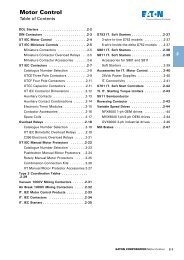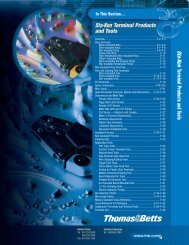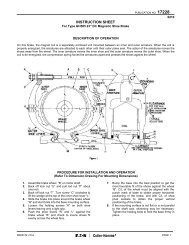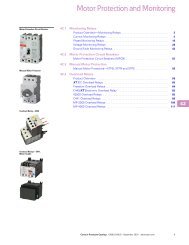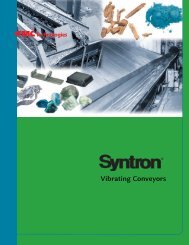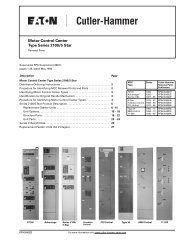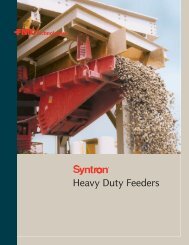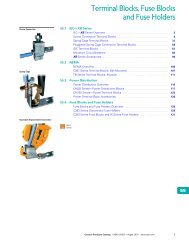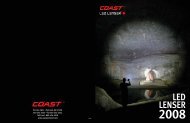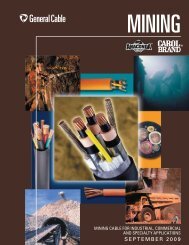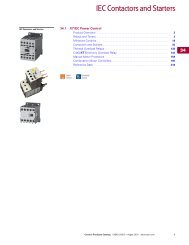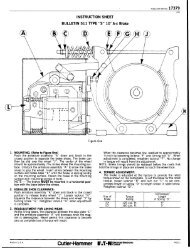Syntron® Vibrators - FMC Technologies
Syntron® Vibrators - FMC Technologies
Syntron® Vibrators - FMC Technologies
Create successful ePaper yourself
Turn your PDF publications into a flip-book with our unique Google optimized e-Paper software.
Basic Formula<br />
FORMULA<br />
e = S / 2 SM t = W t x e W t = W s + W v a = CF t / W t<br />
e = SM t / W t S = e x 2 CF t = W t x a<br />
LEGEND<br />
e = Eccentricity (in.)<br />
s = Total Stroke (Peak to Peak) (in.)<br />
a = Acceleration (Number of G’s)<br />
SM t = Total Static Moment (Static Moment of vibrator x number of vibrators) (lb*in)<br />
CF t = Total Centrifugal Force (Centrifugal Force of vibrator x number of vibrators) (lb)<br />
W t = Total Weight of machine (structure + vibrators) (lb)<br />
W s = Weight of isolated structure (lb)<br />
W v = Weight of vibrator (Weight of vibrator x number of vibrators) (lb)<br />
SMv = Static Moment of vibrator (lb*in)<br />
Speed and Stroke<br />
MAX<br />
STROKE<br />
Hz POLE SPEED at 5 G’S<br />
50 8 750 .60 in.<br />
60 8 900 .43 in.<br />
50 6 1,000 .35 in.<br />
60 6 1,200 .26 in.<br />
50 4 1,500 .18 in.<br />
60 4 1,800 .12 in.<br />
50 2, AMV 3,000 .05 in.<br />
60 2, AMV 3,600 .04 in.<br />
* As a general rule it is advisable to limit designs for a maximum<br />
of 5 G’s of acceleration. In specialized applications or designs it<br />
may be acceptable to exceed the 5 G acceleration limit. Consult<br />
factory for guidelines.<br />
Example:<br />
Known information:<br />
Type of process = quarry primary feeder Stroke (from table) = .26<br />
Type of vibration = linear (2 vibrators) Speed (from table) = 1,200 RPM<br />
Weight of vibrating structure = 3,300 lb Power Supply = 60 Hz<br />
Estimated vibrator’s weight: = 825 lb (25% of vibrating<br />
structure)<br />
Vibrator rough selection:<br />
I. Considering the known information from above use the table on page 18 to determine rough Speed (RPM) needed.<br />
(In the example above the RPM range is 900 - 1,200 for a Primary Feeding process at 60Hz.)<br />
II. Using the Speed and Stroke table above, select the appropriate vibrator pole size based on your Hz and Speed<br />
requirements. (In the example above the pole selection is 6 based on 60Hz and 1,200 Speed (RPM).)<br />
III. Using the formulas below, determine SM v (Static Moment) required for this application.<br />
a. e = S / 2 = > .26 / 2 = .13 in<br />
b. SM t = W t x e = > (3300 + 825) x .13 = 536<br />
c. SM v = SM t / Number of <strong>Vibrators</strong> = > 536 / 2 = 268 lb*in<br />
IV. Referencing the charts on pages 20 - 29 the <strong>FMC</strong> model number selection is SPV6-14000 based on 6 pole, 60Hz and a Static<br />
Moment of 268 or greater. (Actual Static Moment for this vibrator is 319.7)<br />
Checking the <strong>FMC</strong> model selection:<br />
SM t = SM v x 2 = 319 (actual SM v from page 26) x 2 = 638 lb*in<br />
W t = W s + W v = 3300 + (477 (actual wt from page 26) x 2) = 4254.0 lb<br />
e = SM t / W t = 638 / 4254 = .15 in<br />
* In the example above by using two SPV6-14000 vibrators, the desired eccentricity 0.13 can be reached with 87% setting of weights (SMt 638 x 87% = 555/4254 = .13 in).<br />
* If additional adjustments are required, the following larger model SPV6-15000 can be selected, recalculating the eccentricity formula to reach 81% of weight setting.<br />
* When selecting a vibrator it is always advisable to use approximately 80% of the Static Moment or Centrifugal Force reported in the catalog in order to leave<br />
20% of extra performance available in case on site adjustments are required. According to this assumption all our vibrators are set at 80% before shipment.<br />
Material Handling Solutions<br />
www.fmctechnologies.com/materialhandling<br />
19



